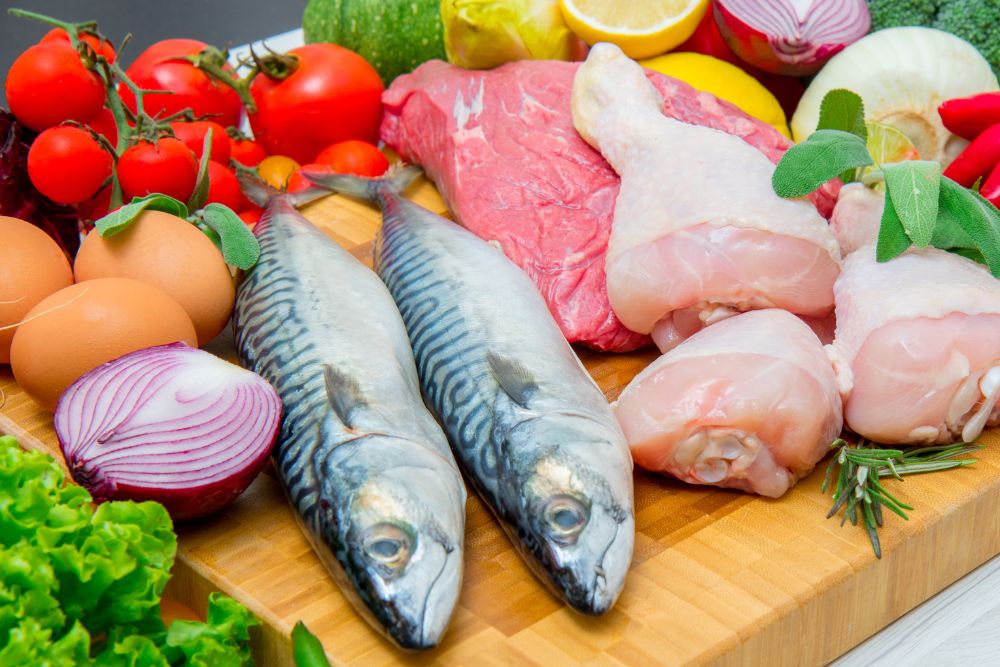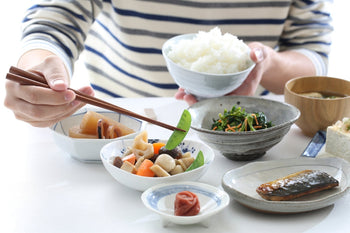

UNESCO recognized Japanese cuisine as an "intangible cultural heritage" in 2013.
Today, we will focus on the main ingredients of the huge variety of Japanese dishes, starting from their etymology and describing some of the main recipes you can enjoy during your trip to Japan!
Meat in Japanese
To refer to "meat" in Japanese, you would say "肉" (にく, niku), or "お肉" (おにく, o-niku),
where the prefix "お" (o) is an honorific expression that shows respect and gratitude to the food and to the person you are talking with. The ideogram represents a slice of meat with some visible tendons.
Let's look at some of the most common meat types in Japan.
Beef in Japanese
"Beef" can be translated as "牛肉" (ぎゅうにく, gyūniku) in Japanese.
● “牛” (ぎゅう, gyū) means “cattle”
● "肉" (にく, niku) is the ideogram for "meat"
Japanese beef is known for its tenderness and delicate texture: in particular, wagyu beef, a specific category made from one of the four selected Japanese beef cattle breeds, is one of the most expensive meat types in the world. Wagyu beef cattle are grown and cared for under specific conditions, and even the water they drink is strictly controlled. As a result, wagyu beef features marbling, which allows an overall moist and tender consistency.
There are many famous Japanese beef dishes: an example is "しゃぶしゃぶ" (shabu-shabu),
a hotpot dish composed of thin slices of meat and vegetables boiled in broth and served
with dipping sauces. A similar hotpot dish is "すき焼き" (すきやき, sukiyaki), which features
a special boiling sauce made of soy sauce, mirin (a type of rice vine used for cooking), and
sugar. Grilled beef called "焼肉" (やきにく, yakiniku) is largely appreciated, too: it derives from
Korean barbecue and is again characterized by its savory yet sweet flavor.
Pork in Japanese
"Pork" is called "豚肉" (ぶたにく, butaniku) in Japanese.
● “豚” (ぶた, buta) means “pig”
● "肉" (にく, niku) is the ideogram for "meat"
Pork is considered the most consumed meat among Japanese people: a popular dish is "とんかつ" (tonkatsu), a deep-fried cutlet primarily appreciated also by foreign visitors for two unique aspects that characterize this dish: in the first place, the pork meat is incredibly tender even though it is cut into very thick slices; in addition, Japanese breadcrumbs are way crisper and airier than the ones used in Western cuisine, and give the cutlet an inimitable texture!
Another example is "肉じゃが" (にくじゃが, nikujaga): it is one of the most known Japanese home-cooked meals and consists of beef, potatoes, carrot, and onion stewed in a sweet, soy sauce-based broth.
You can find pork meat in many more dishes, including ramen, dumplings, and curry-and-rice.
Chicken in Japanese
The Japanese word for "chicken" is "鶏" (にわとり, niwatori), literally meaning "garden bird".
To refer to "chicken meat", you would say "鶏肉" (とりにく, toriniku):
● "鶏" (とり, tori) means "chicken"
● "肉" (にく, niku) is the ideogram for "meat"
Japan has many types of chicken meat, including local, brand, and broiler chicken. Local chickens must be at least 50% native, meaning that at least one "parent" needs to belong to one of the 38 recognized breeds. Among the many kinds of Japanese chicken dishes, we would like to introduce you to three
of the most appreciated varieties: first of all, the well-known "焼き鳥" (やきとり, yakitori), skewered chicken dipped in sweet soy sauce and grilled over a charcoal fire.
Another famous dish is "親子丼" (おやこどん, oyakodon): it means "parent-and-child on rice" and consists of a bowl of rice with chicken and scrambled eggs. It has again a sweet and savory flavor.
Last but not least, a dish you've undoubtedly heard before if you are into Japanese cuisine! "唐揚げ" (からあげ, karaage) is a fried food consisting of seasoned chicken covered in potatostarch.
Lamb and mutton in Japanese
Lamb and mutton meat are both referred to as "羊肉" (ひつじにく, hitsujiniku) in Japanese.
● “羊” (ひつじ, hitsuji) means “sheep”
● "肉" (にく, niku) is the ideogram for "meat"
Sheep meat is less consumed compared to the types above because the habit of breeding these animals was not widespread until the XIX Century. You can still find it in most supermarkets today, but it is pretty expensive, and more than 99% of it is imported from Australia. Still, there is a place in Japan where mutton meat is a product consumed daily: Hokkaido, the northernmost island, is known for its popular dish "ジンギスカン" (jingiskan, a transliteration of "Genghis Khan"), which was inspired by the Chinese grilled mutton. Jingiskan consists of mutton meat and vegetables grilled with soy sauce or sake-based sauce.

Seafood in Japanese
"Seafood" is often called "シーフード" (shīfūdo), a borrowed word from its English correspondent form. Another translation can be" 魚介類" (ぎょかいるい, gyokairui):
● “魚” (ぎょ, gyo) means “fish”
● “介” (かい, kai) means “world”
● “類” (るい, rui) means “species”
This term does not only have a culinary meaning, as it refers to marine creatures in general, non-edible ones included. Seafood is an essential part of the Japanese culinary culture: some of the main seafoods are cooked in Japan.
Fish in Japanese
Fish is written as "魚" (さかな, sakana). Fish has always been the primary energy source in the Japanese diet: this is because
eating "animals with four legs" was prohibited by Buddhism. Therefore, more than 300 fish types are sold in Japanese markets nowadays. Every fish type has its "旬" (しゅん, shun), which is the best period in the year to consume it, based on the peak of its flavor and freshness: already during the Edo period (between XVII and XIX Centuries), people would pay high costs to get the best Bonito (a popular type of fish).
Tuna in Japanese
To refer to "tuna" in Japanese, you would say "鮪" (まぐろ, maguro).
You can also find the borrowed term "ツナ" (tsuna) in Western dishes such as sandwiches.
Tuna is the most consumed fish in Japan: the zone between Hokkaido (the northernmost island) and Honshū (the main island) is one of the best spots in the world to catch the best tunas, which are immediately taken to fish markets to be divided into parts and sold to different restaurants:

Ōtoro
"大トロ" (おおとろ, ōtoro) means "great belly region".
It is the fattiest and most expensive portion, usually served raw in sushi or sashimi.
Chūtoro
"中トロ" (ちゅうとろ, chūtoro) means "medium belly region".
It is the second fattiest and most expensive portion and is again usually served raw to preserve its flavor and freshness.
Akami
"赤身" (あかみ, akami) is made of two ideograms:
● “赤” (あか, aka) means “red”
● “身” (み, mi) means “body”
It is the red region, which is not fatty and is usually used in nigiri sushi and rolls, often mixed
with green scallions.
Other parts are sold to different restaurants that serve cooked tuna: it could be either grilled
as a steak, boiled to make broth, or even fried.
Salmon in Japanese
"Salmon" is often referred to as "鮭" (さけ, sake), but you can also find the term "サーモン" (sāmon), another borrowed word from English. Salmon is the second most consumed fish in Japan. When you think about salmon in Japanese cuisine, you would probably immediately think about salmon sushi... but actually, it is not a Japanese invention! Until the '80s, the Japanese used to eat salmon only if it was fully cooked because of the presence of parasites that could cause health issues if eaten raw. It was when Japan started importing Norwegian aquacultured salmons, which were safer than the wild ones the Japanese were used to. Nowadays, salmon is enjoyed raw and cooked and appreciated for its delicious broth!
Shrimp in Japanese
Shrimps are called "海老" (えび, ebi) in Japanese.
● “海” (え, e) means “sea”
● "老" (び, bi) means "old"
It is because shrimps have a long "beard" and a recurved abdomen that recall the features of an old man. Shrimps are important in Japanese cuisine: they can be served as sushi (both raw and cooked), grilled, and fried. Fried shrimp, called "エビフライ" (ebifurai), is a popular dish loved by kids, adults, and foreigners, too. It is covered in Japanese breadcrumbs and has a slightly sweet, delicious flavor.

Vegetable in Japanese
The word "vegetable" can be translated to "野菜" (やさい, yasai) in Japanese.
● "野" (や, ya) means "field"
● "菜" (さい, sai) means "vegetable" or "side dish"
Let's talk about some of the vegetables used in a Japanese kitchen.
Onion in Japanese
To refer to "onion" in Japanese, you would say "玉ねぎ" (たまねぎ, tamanegi). The first ideogram means "round", while the last two letters mean "scallion". Onions were originally grown in Europe and Middle Asia, and since Japan had minimal contact with foreign countries for several centuries, they were not popular until the late XIX Century; in addition, when they were finally imported, they were used for aesthetic purposes in Nagasaki, until Japanese started cultivating them in 1880. Nowadays, onions are very popular for their peculiar flavor and nutrient properties.
Carrot in Japanese
Carrots are called "人参" (にんじん, ninjin).
● “人” (にん, nin) means “human”
● “参” (じん, jin) means “comparison”
But why are carrots named like that? It is because they were first imported from Korea as medicines and Korean carrots had a similar shape to human bodies. After being imported in the XVI-XVII Centuries, carrots spread rapidly all over Japan. Nowadays, you can find carrots in almost every hotpot dish and in popular home-cooked recipes such as the nikujaga we talked about before.
Mushroom in Japanese
Mushrooms are referred to as "茸" (キノコ, kinoko).
It means "tree kid" because mushrooms often grow in the proximity of, or even from trees. The most popular Japanese mushrooms are undoubtedly "椎茸" (しいたけ, shītake): they have short, white stems and relatively large brown caps. Shītake is appreciated for being rich in vitamins B and D and stimulating immune cells. They are often found in "おでん" (oden), a popular dish consisting of roots, vegetables, and mushrooms boiled in broth.

Fruit in Japanese
The Japanese word for "fruit" is "果物" (くだもの, kudamono).
● "果" (くだ, kuda) means "fruit" from a scientific point of view, so it also comprehends
non-edible ones)
● "物" (もの, mono) means "thing."
Another expression you can often find is "フルーツ" (furūtsu), a borrowed word from English; it is considered a more elegant and fancy word. Japanese fruits are famous for their exquisite, sweet flavors, and often for their big sizes; they can be quite expensive and are often given as gifts.
Banana in Japanese
Japanese use the borrowed word "バナナ" (banana).
Bananas are very popular in Japan: together with apples, they can be found in every house, no matter the year!
Fun fact: even though bananas are not a local product, the official souvenir sweet of Tokyo is "東京ばなな" (とうきょうばなな, Tokyo banana), a banana-shaped and flavored sponge cake filled with banana puree cream.
Strawberry in Japanese
Strawberries are called "苺" (いちご, ichigo) in Japanese.
This ideogram is composed of two parts: the upper part refers to plants, while the lower part is a kanji itself that means "mother": it is because, starting from a single strawberry, dozens of plants can grow! They can be found especially during late Spring to early Summer. The most famous Japanese strawberries are called "あまおう" (amaou): they are popular for their natural sweetness and their big, rounded appearance. Strawberries have a main role in confectionery: you can find them in Western-inspired pastries and traditional Japanese sweets.
Apple in Japanese
To refer to "apple" in Japanese, you would say "林檎" (りんご, ringo).
● “林” (りん, rin) means “trees”
● "檎" (ご, go) means "bird" in Chinese
It is because the sweet flavor of apple trees often attracts birds. You can also find the borrowed term "アップル" (appuru). It is again a fancy expression often used in restaurants and pastry shops. Japanese apples are famous worldwide; have you ever heard of Fuji apples? They are relatively large apples that are appreciated for their crispy flesh and surprisingly sweet flavor. During folklore festivals, you can always find candy apple vendors; this tradition started right after WW2, during the Showa period (1926-1989).

Pineapple in Japanese
Pineapples are referred to with the borrowed word "パイナップル" (painappuru), or with the shorter term "パイン" (pain).
Pineapples are not native to Japan, but many islands of Ryukyu archipelago (in the southernmost part of Japan) produce them today. Pineapples are often given as gifts for their juiciness and freshness, and nowadays, many pastry shops sell pineapple cakes.
Grape in Japanese
You can refer to "grapes" in Japanese with the word "ぶどう" (budou), but not only. More rarely, you can also find the kanji form "葡萄" (ぶどう, budou), which was originally a Chinese word used to indicate the word "grape" in Persian (which was pronounced "budau"). Also in this case, two borrowed terms are used as well: "グレープ" (gureipu) usually refers to black grapes, while "マスカット" (maskatto) is associated with white grapes. Grape is another fruit that is very often used in the sweets industry: Japan has many grape-flavored candies and snacks, and you can buy grape juice even from vending machines in the neighborhoods! Also, a Japanese grape type called Shine Muscat has become extremely popular in recent years: you can find a lot of Shine Muscat-flavored pastries,parfaits, and juices in many cafes and shops!
The Japanese culinary universe is a fascinating, constantly evolving mixture of local traditions and foreign products: even though the country itself has had little to no contact with the outside world for many Centuries, we all can see how Japan has shown interest andenglobed new ingredients and culinary methods every time it had to meet a new culture. It is interesting to see how a country's cuisine can be so varied, and getting to
Know that some of their main ingredients will make you enjoy your trip to Japan even more!




